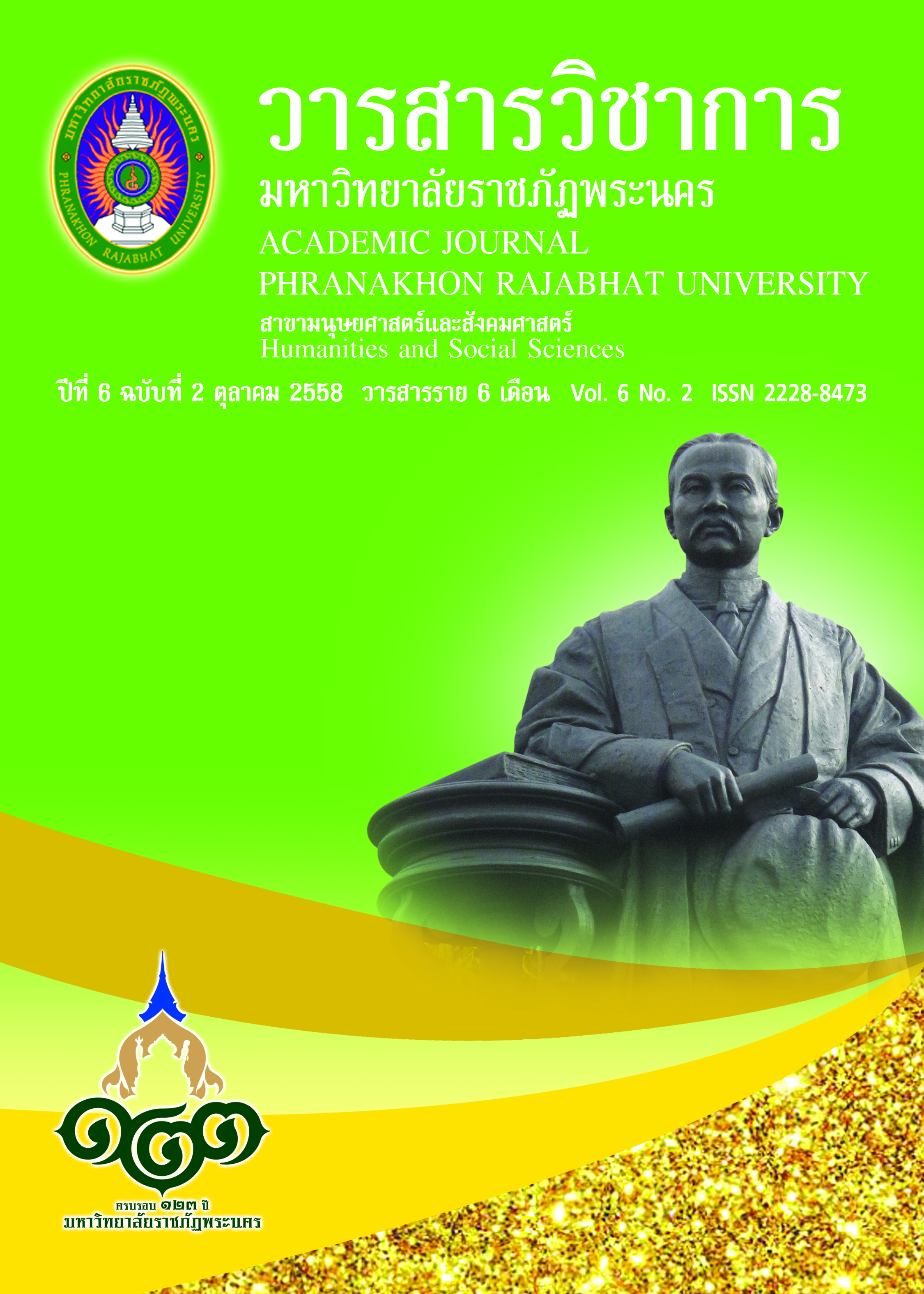ปแบบการจัดการความรู้การบริการสิทธิประโยชน์ แรงงานนอกระบบของสำนักงานประกันสังคมกลุ่มจังหวัด ภาคตะวันออกเฉียงเหนือตอนบน 1
Keywords:
รูปแบบการจัดการความรู้, การบริการ, สิทธิประโยชน์, แรงงานนอกระบบ, Knowledge Management Model, Benefits Service, Informal SectorAbstract
การวิจัยในครั้งนี้มีวัตถุประสงค์เพื่อ 1) วิเคราะห์ สังเคราะห์ แนวคิด ทฤษฎี สภาพปัญหาและอุปสรรคในการจัดการความรู้การบริการสิทธิประโยชน์แรงงานนอกระบบของสำนักงานประกันสังคมกลุ่มจังหวัดภาคตะวันออกเฉียงเหนือตอนบน 1 2) สร้างรูปแบบการจัดการความรู้การบริการสิทธิประโยชน์แรงงานนอกระบบ 3) ทดลองใช้รูปแบบการจัดการความรู้การบริการสิทธิประโยชน์แรงงานนอกระบบ 4) ประเมินรูปแบบการจัดการความรู้การบริการสิทธิประโยชน์แรงงานนอกระบบ โดยใช้กระบวนการวิจัยและพัฒนาวิธีดำเนินการวิจัยแบ่งออกเป็น 4 ขั้นตอน ได้แก่ ขั้นตอนที่ 1 การวิเคราะห์ และสังเคราะห์ แนวคิด เกี่ยวกับสภาพ
ปัญหาและอุปสรรคใน การจัดการความรู้การบริการสิทธิประโยชน์แรงงานนอกระบบ กลุ่มเป้าหมายได้แก่แรงงาน นอกระบบที่อาศัยอยู่ในเขตสำนักงานประกันสังคมกลุ่มจังหวัดภาคตะวันออกเฉียงเหนือตอนบน1 รวมจำนวน 391 คน หัวหน้าฝ่ายประโยชน์ทดแทนฝ่ายทะเบียนและประสานการแพทย์ และฝ่ายสมทบ และการตรวจสอบ เจ้าหน้าที่แรงงานนอกระบบ ใน 5 จังหวัด ๆ ละ 5 คน รวม 25 คน โดยใช้แบบสัมภาษณ์แบบมีโครงสร้างและผู้ทรงคุณวุฒิ จำนวน 5 คน เครื่องมือ ได้แก่ แบบสรุปประเด็นปัญหาและบันทึกการสนทนากลุ่ม และสังเคราะห์เนื้อหาโดยการพรรณนา ขั้นตอนที่ 2 นำสารสนเทศจากขั้นตอนที่ 1 สร้างรูปแบบการจัดการความรู้การบริการสิทธิประโยชน์แรงงานนอกระบบ และตรวจสอบความเหมาะสม และความเป็นไปได้ของรูปแบบฯ ด้วยเทคนิคการประชุมอภิปรายหาข้อสรุปความสอดคล้อง (Multi-Attribute Consensus Reaching: MACR) โดยผู้ทรงคุณวุฒิ จำนวน 10 คนเครื่องมือที่ใช้เป็นแบบสอบถามมาตราส่วนประมาณค่า 5 ระดับ สถิติที่ใช้วิเคราะห์ได้แก่ ค่ามัธยฐาน และค่าพิสัยควอไทล์ ขั้นตอนที่ 3 ทดลองใช้รูปแบบฯ ในกลุ่มเป้าหมาย 1 ตำบล จำนวน 90 คน เทคนิคที่ใช้ได้แก่ การประชุมเชิงปฏิบัติการ เครื่องมือที่ใช้คือรูปแบบฯ และใช้การวิเคราะห์เนื้อหา ขั้นตอนที่ 4 ประเมินผลรูปแบบฯ กลุ่มเป้าหมายคือกลุ่มผู้ใช้ จำนวน 105 คน เครื่องมือ ที่ใช้แบบสอบถาม และแบบสัมภาษณ์ สถิติที่ใช้วิเคราะห์ได้แก่ ค่าเฉลี่ย ค่าเบี่ยงเบนมาตรฐาน และค่าพิสัย ระหว่างควอไทล์ ผลการวิจัยสรุปได้ ดังนี้ 1. ประชาชนมีการรับรู้และความเข้าใจเกี่ยวกับการบริการสิทธิประโยชน์ประกันสังคมที่ระดับปานกลางส่วนใหญ่สมัครรับสิทธิประโยชน์ประกันสังคม มาตรา 40 ทางเลือกที่ 2 เงินสมทบ 150 บาท / เดือน ขาดความพร้อมในการยื่นคำขอประโยชน์ทดแทนกรณีกรณีเจ็บป่วย ทุพพลภาพ ชราภาพ เสียชีวิต และสถานที่จ่ายเงินไม่สะดวกในการบริการ 2. รูปแบบการจัดการความรู้การบริการสิทธิประโยชน์แรงงานนอกระบบเป็นเชิงระบบ ได้แก่ ปัจจัยนำเข้า ประกอบด้วย นโยบายรัฐบาลในการการคุ้มครองสิทธิประโยชน์ของแรงงานนอกระบบ พระราชบัญญัติประกันสังคม สภาพปัจจุบันของประชาชนที่เป็นแรงงานนอกระบบ กระบวนการ ประกอบด้วย การประชุมเจ้าหน้าที่เกี่ยวกับนโยบายสิทธิประโยชน์ประกันสังคมมาตรา 40 การระดมสมองในการนำนโยบายสู่การปฏิบัติตามขั้นตอนการจัดการความรู้ ดำเนินการจัดทำแผนและคู่มือ นำแผนสู่การปฏิบัติ และประเมินผลการดำเนินงานจากผู้มีส่วนได้เสีย ผลลัพธ์ ประกอบด้วย ประชาชนเข้าใจและปฏิบัติตามระเบียบสิทธิประโยชน์แรงงาน นอกระบบมาตรา 40 สำนักงานงานประกันสังคมมีรูปแบบการจัดการความรู้การบริการสิทธิประโยชน์แรงงานนอกระบบที่นำไปปฏิบัติได้ 3. ผลการทดลองใช้รูปแบบการจัดการความรู้การบริการสิทธิประโยชน์แรงงานนอกระบบ โดยลองใช้ในพื้นที่ตำบลปะโค อำเภอกุมภวาปี จังหวัดอุดรธานีจำนวน 3 กลุ่ม กลุ่มละ 30 คน รวมทั้งสิ้น 90 คน พบว่าประชาชนมีคะแนนเฉลี่ยหลังการใช้รูปแบบการจัดการความรู้การบริการสิทธิประโยชน์แรงงานนอกระบบสูงกว่าก่อนการใช้รูปแบบ อย่างมีนัยสำคัญทางสถิติที่ระดับ 0.01 4. รูปแบบการจัดการความรู้การบริการสิทธิ ประโยชน์แรงงานนอกระบบของสำนักงานประกันสังคมกลุ่มจังหวัดภาคตะวันออกเฉียงเหนือตอนบน 1 มีความเป็นประโยชน์ ความเป็นไปได้ ความเหมาะสม และความถูกต้องในระดับมากที่สุด
The purposes of this research were to 1) Study problems of benefit services for informal sectors of Social Security Office, in Northeast cluster 1. 2) Create the knowledge management model on benefit services for informal sectors. 3) Trial the model of knowledge management on benefit services for informal sectors. 4) Evaluate the model of knowledge management on benefit services for informal sectors using the research and development process. The research method was divided into four stages: Stage 1 was to study problems of benefit services for informal sectors. The target groups were 381 informal sectors in Social Security Office in Northeast cluster 1. Participants included five informal sector officers from five different provinces (25 people in total) using structured interviews, and five experts were also included. The instruments were a summary of problems and the record of the group discussion. Synthesized content was descriptive. Stage 2 was to bring information science from Stage 1 and create a knowledge management model of benefit services for informal sectors. The model was approved appropriately by 10 experts for the possibility of a model of knowledge management with the Multi-Attribute Consensus Reaching (MACR) technique. A questionnaire with five rating scale was used as the research tool. The statistical analysis tools used including median and quartiles range. Stage 3 was the trial of the model of knowledge management into the target district with 90 people, including techniques used as workshops. The instruments were a model of knowledge management and content analysis. Stage 4 was the evaluation of knowledge management model with the target group of 105 users. Questionnaires and interviews were used. The statistical analysis tools were mean, standard deviation and the inter-quartile range. The results were as follows: 1. People had awareness and understanding about benefit services of Social Security at a moderate level. There was a lack of availability of the applicant to apply for the compensation in case of sickness, disability, old age benefit in case of death, and the place of payment was not convenient. 2. The knowledge management model of benefit services for informal sectors was systematic, such as import factors including government policies, social security act, current situation of informal sectors. The process consisted of a staff meeting about Social Security benefits policies, brainstorming of the policy into practice on the knowledge management process, providing an action plan and manual, taking a plan into action and evaluating results of the stakeholders. The results included that people understood and followed the rules of section 40. The Social Security Office had the knowledge management model on benefit services for informal sectors that were practical. 3. The results of the experiment of knowledge management model on benefit services for informal sectors found that people had average scores after implementing a model of knowledge management on benefit services for informal sectors that were higher than using previous model for statistically significant at the 0.01 level. 4. The model of knowledge management on benefit services for informal sectors of Social Security Office in Northeast cluster 1 had the advantage, feasibility, appropriateness and validity at a highest level.
Downloads
How to Cite
Issue
Section
License
"บทความวิชาการในวารสารฉบับนี้ ถือเป็นความรับผิดชอบของผู้เขียนเท่านั้น"
สงวนลิขสิทธิ์ตามพระราชบัญญัติลิขสิทธิ์




